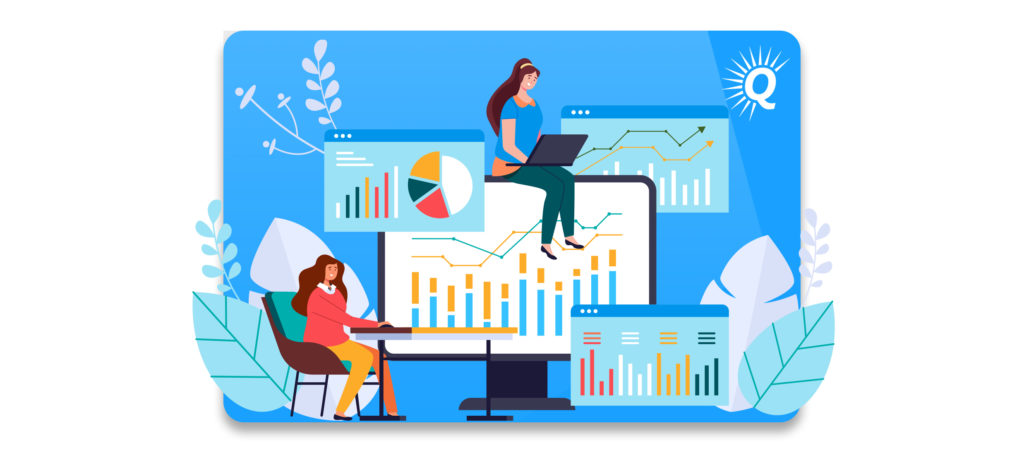Topics:
Never Miss a Beat - Get Updates Direct to Your Inbox
FILTER:


Understanding Valuation Metrics for Business Owners
By Ian Drogin


Just as every explorer needs a compass, entrepreneurs require their own set of tools for establishing clarity and direction for business operations. Without the right metrics in mind, owners are no better off than lost travelers wandering aimlessly in the desert.
For most owners, the best “compass” is a real-time dashboard that shows all of the relevant critical valuation metrics in your business. Together, those metrics determine how much your business is truly worth.
This article explains each of the core valuation metrics you need to know and use, to succeed.
Thinking of Selling Your Business?
Get a free, individually-tailored valuation and business-readiness assessment. Sell when you're ready. Not a minute before.
Business Valuation and Valuation Metrics
Many owners don’t think about the value of their business until they want to sell. Unfortunately, this approach often leads to lower business values and higher stress than if they had planned ahead and paid close attention to their valuation metrics.


Although there are different metrics that apply to different industries, there are certain metrics that are important across the board. These include:
- Seller’s Discretionary Earnings (SDE)
- Growth rate
- Profit margin
- Number of revenue streams
Seller’s Discretionary Earnings
Seller’s Discretionary Earnings is one of the most important metrics used to determine typical business value. In fact, it’s easy to argue that it’s the most critical metric for investors.
Seller’s Discretionary Earnings (SDE) are the pre-tax, pre-interest profits of the business. Also, SDE does not include:
- Non-cash expenses
- Owner’s benefits
- Unrelated income
- Discretionary expenses
- One time investments


In simpler terms, SDE are a business’s profits before subtracting expenses that won’t necessarily be transferred to the new owner. The intention of SDE is to show how much money a new owner can expect to earn from the business following an acquisition.
“Seller’s Discretionary Earnings is one of the most important metrics used to determine typical business value.”
For a more in-depth understanding of SDE, be sure to check out our previous article about Seller’s Discretionary Earnings.
To understand the paramount importance of SDE, it’s important to understand how the valuation process works.
Buy a Profitable Online Business
Outsmart the startup game and check out our listings. You can request a summary on any business without any further obligation.
Understanding Business Valuation
Most online businesses are valued using the SDE multiple method.
In broad summary, the SDE multiple method is very simple: You take the business’s SDE and multiply it by a number known as the “multiple” or “valuation multiple”.
There are numerous factors involved with determining the SDE and the multiple (covered in greater detail below).
Although the SDE multiple method applies to most online businesses, it’s important to note that certain companies are valued differently.


For example, medium or large software companies are sometimes valued using the revenue multiple method, which basically replaces SDE with revenue. This valuation method is typically used when revenue is seen as a more important metric than SDE for a business.
In certain other cases, the fair market value is determined using an EBITDA multiple or equity multiple. However, it remains that the SDE multiple method applies for the vast majority of online businesses.
Growth Rate
A business’s growth rate plays a significant role when determining the valuation multiple.
In business valuation, there are four primary areas (the Four Pillars of Value) that buyers at. Growth is one of them.
“A business’s growth rate plays a significant role when determining the valuation multiple.”
It’s no surprise that investors, including private equity firms, are eager to acquire businesses that are trending upward. Therefore, all else being equal, they’ll be willing to spend more money attaining a business with promising growth potential.
Within the realm of growth, there are two main metrics are examined:
- SDE growth
- Revenue growth
SDE Growth
Common sense tells us that if a business has positive and consistent SDE growth, a new owner can reasonably expect the business to earn more money in the future than it currently does. Depending upon the SDE growth rate, the new owner may be able to experience a significantly higher ROI.
Since a high earnings growth rate has obvious value, this leads to businesses being valued at a higher multiple.


On the other hand, if a business’s net income is trending downward, investors will be wary. No one wants to buy a business that ends up being unprofitable in the future. While businesses with negative SDE growth trends can certainly be sold, they will typically be valued at a much lower multiple.
Revenue Growth
While positive SDE growth suggests that a new owner can experience immediate cash-flow gains following an acquisition, revenue growth often indicates longer-term viability and success. Of course, revenue and SDE growth often accompany one another, but there are some key differences.
If a company is investing heavily in customer acquisition efforts, their revenue growth may outpace their SDE growth, sometimes significantly.


In certain cases, such as some early-stage SaaS business start-ups or subscription-based eCommerce businesses, a company may choose to reinvest a large capital expenditure each month to acquire customers. These customers would be expected to become profitable in the long-term through their annual recurring revenue.
In these situations, the company may have rapid revenue growth but unchanged SDE. Such businesses will be valued at a higher multiple due to the higher future earnings that are expected to materialize.
Profit Margin
A healthy profit margin generally indicates that a business is being run efficiently, has high growth potential, and a certain level of stability.
High margins suggest that the owner has taken the time to optimize all business processes. In the case of an eCommerce business, this might mean cost-efficient product sourcing, a lean supply chain, optimized ad campaigns, and a low rate of returns.
“A healthy profit margin generally indicates that a business is being run efficiently, has a high growth potential, and a certain level of stability.”
High margins also suggest that the business offers a unique product and doesn’t need to engage in price wars with competitors.
Additionally, high margins provide new owners with greater opportunities. With more money available, they can experiment with different paid marketing strategies or distribution methods to increase sales.


As far as stability is concerned, high margins ensure that there’s more “room for error” in the event of unfortunate circumstances. If a business has a slim margin, even a small rise in raw material or advertising costs could jeopardize the entire business model.
For example, if an eCommerce business has a 10% margin (after fulfillment fees and advertising costs) on a product that they sell for $20, it means they’re only earning $2 per sale in profit. Let’s also say that the product costs them $10 to source. Based on this, if their product cost increases just 20% to $12 per unit (it happens!), their margin will immediately disappear.
On the other hand, if a business sells a product for $30 that they source for $10, they may have a margin that is closer to 40% ($12 per unit) after paying fulfillment fees and advertising costs. If their product cost jumps from $10 to $12, they’ll still have a healthy margin above 30%.
Smart buyers appreciate healthy margins for all of the reasons above, and will often be willing to pay more for them.
Revenue Diversification
Investors have a strong affinity for acquiring businesses that have low risks (another one of the Four Pillars of Value).
If a business relies too heavily on a single revenue stream, it’s more vulnerable than a business that has several different earning methods.


For example, imagine you’re trying to sell an Amazon business with one product that earns $100,000 per month. In this scenario, the business is teetering on a foundation of “one block”. There’s always the possibility that a number of events could impact that one product. One hit and the business topples over and loses all revenue. Potential buyers will be wary.
On the other hand, if your business has ten products that each earn $10,000 per month, the business will have the same revenue with a lot less risk on the balance sheet. If conditions dictate that you have to stop selling one product, you’ll still have $90,000 in monthly revenue.
When building value in a business, smart entrepreneurs usually seek to create multiple revenue streams that help them meet their goals and create business stability.
Advantages and Disadvantages of Valuation Metrics
Valuation metrics are extremely useful for establishing the fair value of online businesses. However, they also have some clear limitations in the valuation process.
Advantages of Using Valuation Metrics
Simply put, it’s almost impossible to value online businesses without having access to key valuation metrics. No smart buyer would ever consider purchasing a business without understanding its cash flow, discounted cash flow, growth rate, and other important metrics.
“Valuation metrics can help provide a clear and objective understanding of how much a business is truly worth.”
There are several other metrics that are important for publicly traded companies that aren’t too relevant for most online businesses. Some of these include:
- The PEG ratio
- REIT valuation ratio
- PE ratio
- Earnings ratio
- Earnings yield
- Market capitalization
- Dividend yield
When used properly, valuation metrics can help provide a clear and objective understanding of how much a business is truly worth. Instead of relying on guesswork and assumptions, using valuation metrics allows investors to gain invaluable insight into the assets they’re considering.


Valuation metrics also allow business comparisons to be made.
When potential buyers search for investment opportunities, it’s important for them to have tools for evaluating different businesses and understanding the marketplace. After all, even as a high-value investor, it’s hard to know which assets are more appealing unless you’re able to look at comparable companies. Investors will look through the lens that valuation metrics provide and run an analysis of each company for comparison.
The role of the marketplace in determining an individual business’s equity value begs the discussion of intrinsic versus relative valuation (both play an important role).
Disadvantages of Only Using Valuation Metrics
Although valuation metrics are a necessary part of the equation, they simply aren’t able to capture all of the relevant elements involved in determining the true value of a business.
Certain variables, such as year-over-year (YoY) SDE growth rate, are clearly quantitative. As such, they can be easily expressed as metrics (e.g. 10%, 50%, 150%, etc). Other variables are equally important but are limited to qualitative expression.
“Although valuation metrics are a necessary part of the equation, they simply aren’t able to capture all of the relevant elements involved in determining the true value of a business.”
For example, one of the Four Pillars of Value is transferability, which refers to how easily a business can be transferred to a new owner. Unfortunately, there are no hard numbers that reflect how transferable a business is, despite the fact that transferability is an extremely important element in a company’s valuation.


Therefore, buyers need to be careful that they don’t only look at valuation metrics when making investment decisions as there are other crucial variables that don’t qualify as “metrics.”
The role and importance of qualitative information is one reason that business valuation is more of an art than a science. An experienced business advisor can be extremely helpful for navigating the process effectively.
“Buyers need to be careful that they don’t only look at valuation metrics when making investment decisions as there are other crucial variables that don’t qualify as “metrics.””
How to Calculate Valuation Metrics
Just as stock market investors often have stock criteria that guide their investment decisions, business buyers often establish similar criteria based on valuation metrics.
Once you know each valuation metric that is important in your business, it’s time to learn how each one is calculated.
As discussed above, four of the primary valuation metrics include:
- Seller’s Discretionary Earnings (SDE)
- Growth rate
- Profit margin
- Revenue diversification


How to Calculate Seller’s Discretionary Earnings
Previously, we mentioned that SDE are the pre-tax, pre-interest profits before subtracting non-cash expenses, one-time investments, owner’s benefits, and non-related income or discretionary expenses.
Spelled out differently, Seller’s Discretionary Earnings can be calculated by taking the following steps:
- Establish the business’s pretax earnings
- Add any interest expenses and subtract any interest income
- Add any non-cash expenses
- Add one-time investment expenditures
- Subtract non-operating income and add non-operating expenses
- Subtract any discretionary expenses incurred by the business owner
- Add depreciation and amortization expenses
- Add a single owner’s compensation
How to Calculate SDE Growth Rate
To calculate your SDE growth rate, simply subtract your past SDE (e.g. last year’s SDE) from your present SDE, and then divide by your past SDE.
If your growth rate is positive, this equation will result in a positive number. At that point, simply multiply that number by 100 and you have your SDE growth rate expressed as a percentage.


How to Calculate Your Profit Margin
To calculate your gross profit margin, start by subtracting your Cost Of Goods Sold (COGS) from your net sales. This will result in your gross profit.
After determining your gross profit, divide that number by your net sales and then multiply that figure by 100. This will result in your gross profit margin, a financial metric that all business owners love to talk about.
Your net profit margin can be calculated with the same formula simply by substituting your net profit for gross profit.
Revenue Diversification
There are several ways to evaluate a business’s revenue diversification. One way common for service providers is to look at how many clients are responsible for a majority of the company’s revenue.
For e-commerce businesses, most buyers want to see that revenue is driven by multiple products, not just one. Therefore, if you’re an Amazon seller with just one killer product, you may want to consider applying your sales process to more products before selling your business.


Why Use Valuation Metrics When Making Business Decisions
Valuation metrics can provide enormous clarity when making business decisions. A few core benefits of using them in your decision-making processes include:
- Increased growth
- Increased stability
- Owning a more valuable business
“Valuation metrics can provide enormous clarity when making business decisions.”
Growth is an obvious goal, but its importance cannot be overstated. Whether it’s in the context of a SaaS metric or eCommerce trend, growth is always essential to examine. Using growth as one of your primary measures of success can help you understand what actions you should take to create a more profitable business.
Additionally, paying attention to certain company valuation metrics can help you identify aspects of your business that can be improved. For example, if your income statement shows that your gross profits and margin are low, perhaps it’s a good idea to tighten your supply chain or optimize your customer acquisition efforts.
Certainly making decisions that improve your valuation metrics is a great way to increase the book value of your business. If you decide to sell, both you and the new owner will be grateful that you built a business with value in mind.
Thinking of Selling Your Business?
Get a free, individually-tailored valuation and business-readiness assessment. Sell when you're ready. Not a minute before.





